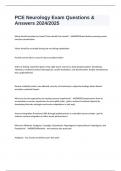PCE Neurology Exam Questions &
Answers 2024/2025
When should sensation be tested? How should it be tested? - ANSWERSTested before assessing motor
function/coordination
Vision should be occluded during but not during explanation
Provide normal stim to area of intact sensation before
Order of testing: superficial (pain, temp, light touch, pressure), deep (proprioception, kinesthesia,
vibration), combined cortical (stereognosis, tactile localization, 2-pt discimination, double simultaneous
stim, graphesthesia)
Record: modality tested, area affected, severity of involvement, subjective feelings about altered
sensation, potential impact
What are the two approaches to treating sensory impairment? - ANSWERSCompensatory (how to
accomodate w sensory impairment to accomplish tasks - goal to achieve functional capacity by
developing alternate strategies and enviro adaptations in safe way)
Sensory Integration (functional skills through guided pratcice w controlled sensory intake - goal to
enhance sensory integration to effect motor performance)
What are Allodynia, Analgesia, Causalgia, Dysesthesia, Hyperalgesia, Hyperasthesia, Hypoalgesia, and
Parasthesia? - ANSWERSAllodynia - non-noxious stim prod pain
Analgesia - loss of pain sensitivity (can't feel pain)
,Causalgia - burning painful sensation, often along N distribution
Dysestehsia - touch sensation prod pain
Hyperalgesia - heightened sensitivity to pain
Hyperasthesia - heightened sensitivity to sensory stim
Hypoalgesia - decr sensitivity to pain
Paresthesia - abnormal sensation w no apparent cause
What are the S/S of a UMN and LMN lesion? - ANSWERSUMN - spastic paralysis, no
atrophy/fasciculations, hyperreflexive, incr tone, hyperactive stretch reflex, involuntary flexor/extensor
spasms, clonus/babinski
LMN - flaccid paralysis, atrophy, fascicultations, hyporeflexia, decr tone/reflexes, msk
fasciculations/fibrillations w denervation
What are the Types of Abnormal Tone? Include any subgroups - ANSWERSHypertonia (incr tonicity)
- spasticity (velocity dependent)
- rigidity (velocity independent - incl leadpipe and cogwheel subtypes)
Hypotonia (decr tonicity)
Dystonia (disordered tonicity)
- generalized
- focal
- segmental
,What are some intervention strategies for abnormal tone, hypotonia, and hypertonia? -
ANSWERSAbnormal tone - stretch, cast, splint, orthoses, sensory stim
Hypotonia - decr support, incr resistance, joint compression, manual facilitation
Hypertonia - incr support, modify tasks, position in lengthened positions, heat
What are the grades of the Modified Ashworth Scale? - ANSWERS0 - no incr in tone
1 - slight incr in tone (catch/release or minimal resistance at end ROM)
1+ - slight incr in tone (catch followed by min resistance through remainder of ROM)
2 - more marked incr in tone through most ROM but affected easily moved
3 - considerable incr in tone, passive movement hard
4 - affect part rigid in flex/ext
What are the grades of DTR reflexes? If someone is having trouble relaxing what can you do for the UE or
LE? - ANSWERS0 - no response
1+ - decr response
2+ - normal response
3+ - exaggerated response
4+ clonus/very brisk
, UE: cross LE's at ankles and isometrically abduct LE's
LE: interlock fingertips and isometrically pull elbows apart
What are the UMN reflexes that can be tested? - ANSWERSConus (ankle DF and hold in full position -
abnormal is sustained clonus of 5+ beats)
Babinski (run pointed object along plantar foot from heel to ball - abnormal is splaying of toes/extension)
Hoffman (flick DIP of middle finger into flexion - abnormal is reflex flexion of distal phalanx of thumb and
distal phalanx of index/middle finger
What tests can we use in order to assess balance? - ANSWERSClinical Test for Sensory Integration in
Balance (CTSIB)
Romberg Test
Functional Reach Tests (FR)
Berg Balance Scale (BBS)
Performance-Oriented Mobility Assessment (POMA)
Get up and Go Test (GUG)
Timed Up and Go Test (TUG)
Community Balance and Mobility Scale (CB&M)




